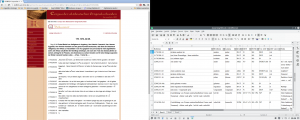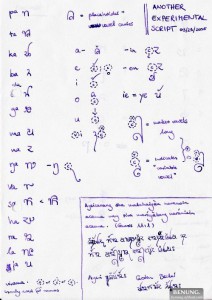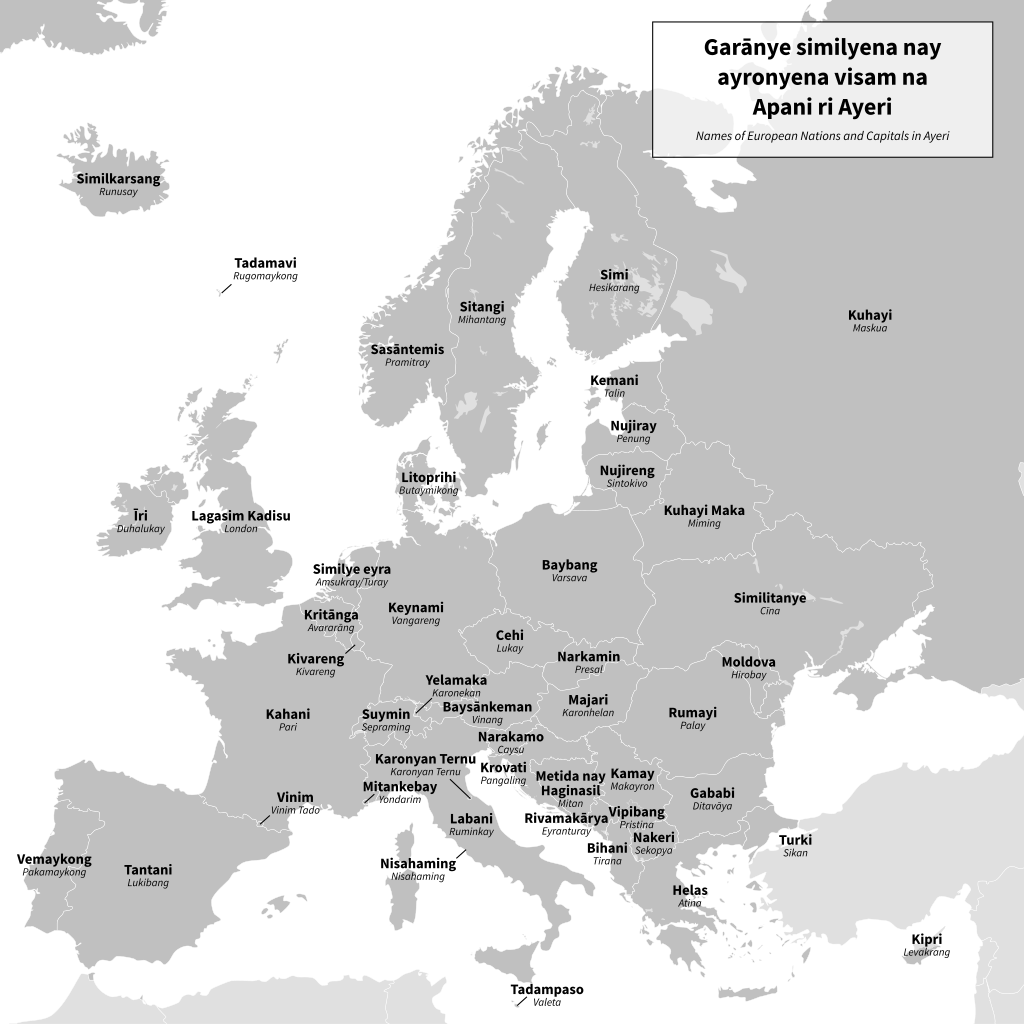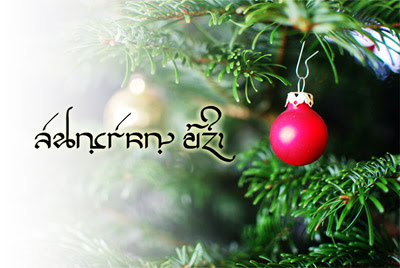- As it turns out, the mini review of Ayeri I’m quoting from below was actually crossposted from 2chan to the blog I got traffic from. I don’t know if the blog author is also the author of the 2chan post, so sorry for any unjust allegations. Also, for having been butthurt about my conlang essentially getting dismissed as trash (apparently under the errorneous impression that it’s somehow supposed to be an auxlang) when I wrote the below post.
The other day, there were visitors from a Japanese blog[1. This link is dead. —CB, 2014-12-05] dropping in according to my site statistics, and I was curious what someone from “the East” would write about my little project here, since the communities I have participated in are dominated by people from “the West” – that is, we don’t get a lot of people from East Asia on the forums I’m on, which are mainly populated by Europeans and North Americans. However, there’s certainly people interested in linguistics and conlanging in Asia, too. Unfortunately, I don’t speak any Japanese, so I piped this through Google Translate and tried to make sense of the output as well as I could.
First off, this guy, who calls himself “Kakis Erl Sax,” appears to be involved in a Japanese community conlanging project called Arka, one of whose members we got into a serious flamewar with on the ZBB due to his missionary zeal of converting us all into followers of what seemed to us like an elitist gig taking itself far too seriously (discussion thread). Since the guy on the forum claimed Arka and the Japanese conlanging community as superior to anything Europe and the US have ever produced in terms of artistic languages, touting Arka as the one and only good model to follow in order to achieve artistic merits in Conlangia, my curiosity immediately became rather ambivalent with the discovery of K.E.S.’s background, not saying that everyone in their community is like that, but first impressions etc. etc. The guy on the ZBB admitted to trolling in the end, basically in an attempt to use any publicity as publicity since he could not get anyone’s interest by just posting site updates for a year, confined to a single dedicated thread. However, his general behavior still left a bad taste in my mouth.
In the following I will quote what was written about Ayeri[1. This link is dead, too, although it appears to have been crossposted to from a 2chan thread where some people from the Arka community sketch out highlights and low points of different conlangs on the internet as far as I could gather from Google Translate. —CB, 2014-12-05] and give the machine translation respectively.
Conlang Ayeriは知らないね。
I do not know Conlang Ayeri is.
Well, it looks like it’s my fictional language project, and this person has chanced on its website on which I present theoretical backgrounds on its being created as well as assorted materials I made using the language over the course of the last couple of years.
みた感じ、音韻体系は中途半端なポリネシア風CV音節で、
I feel, is a phonological syllable CV Polynesian-style half-baked,
If you interpret the overall esthetics of words as inspired by Polynesian languages, it’s no surprise you will find Ayeri “half-baked.” Rather, its esthetics are inspired by Austronesian languages such as Malay and Tagalog, since I somehow like the look of those languages. It is no surprise, thus, that language-guessing algorithms frequently analyze Ayeri as one of Indonesian, Malay, Tagalog, or Cebuano. To me it seems here that the person who wrote this assumes Ayeri was intended to exclusively allow simple CV syllables (almost like Japanese), and in so far I am indeed not very consistent in that many words differ from this pattern. However, all the example texts should suggest that an exclusive CV structure is probably not the basis for my language’s word structure. Thus, the reproach of half-bakedness of my phonotactic system is ungrounded, since Ayeri otherwise appears very consistent in its look and feel.
文字システムはアブギダ、
Abugida character system,
Yep, that’s how I like it.
語彙の借用元は不明、恐らくアプリオリ、
Yuan borrowed vocabulary is unknown, perhaps a priori,
I don’t know where they got the assumption from that Ayeri would not be a priori. I have always assumed that there were enough clues everywhere on the site that Ayeri is fictional, in so far a missing list of loan sources would indicate that there is no external relation. However, since Ayeri’s phonotactics are very similar to those of Malay or Tagalog, it is to be expected that identical words appear with different meanings, but this is mostly just coincidence. In fact, I really wonder how Ayeri looks like to a speaker of the previously mentioned languages.
語彙数ははっきりしないが200以上、
More than 200 the number of vocabulary is not clear,
There are currently about 2,300 entries in the dictionary. From the flamewar mentioned above it became clear, however, that the Arka community very much emphasizes the importance of having as many words as possible, and that the dictionary must have topmost importance in fictional languages: if languages have fewer vocabulary items than Arka, they’re supposedly not ‘elaborate’ enough to be any good. I disagree – partially. It is certainly worth putting effort into a dictionary so that it does not become just a bland copy of your native language, however, if this is your only priority, other parts of your language will necessarily starve from neglect instead, so the location of blandness will simply shift elsewhere. Personally, I am more interested in morphosyntax than lexicography, so my dictionary will likely show some traces of neglect, while more interesting aspects will be found in the interplay of syntax and morphology. Since word creation and grammar creation inevitably go hand in hand, I think what is most beneficial is finding an equilibrium you can work with. A single person can only do so much at a time anyway.
VSO NA 合成語もオランウータン式
Word Orangutan formula also VSO NA synthesis
Asking a friend of mine who studies Japanese what this means, he told me that he was not sure what “orangutan” is doing there. In idiomatic English, the sentence runs as “The VSO/NA/compound word is ‘orangutang style'” according to him. Since orang hutan, lit. ‘man/person forest’, is a right-branching compound and Ayeri tends towards being head-initial, i.e. right-branching, it might be that they used that word as an illustrative metaphor. Alternatively, taking the racism that was exhibited by the guy from the forum into account, it might also be a slur referring to perceived primitivity. Japanese, as Wikipedia informs, prefers a strongly head-final word order, so my language would essentially appear like Yoda-speak to him.
格助詞使用・人称代名詞は補充式で激しく屈折
Personal pronoun use and case particles are violently refraction formula supplementation
Another sentence mangled beyond recognition by automatic translation, this reads more idiomatically as “Case particle usage and personal pronouns are ‘replenish-style’ and considerably distorted,” according to my friend. I have frankly no idea what this could mean other than that they are confused by the case particles and personal pronouns, maybe in so far as there is a large number of either of them, due to there being eight cases, while there is little irregularity that might otherwise be expected.
助動詞後置
Postfix auxiliary
Auxiliary verbs hardly exist in Ayeri. Modals come first in verb phrases and there is no overt copula. Tense is expressed mostly optionally by tense prefixes, mood by suffixes. By now I really think they have just flicked through the grammar quickly and mindlessly while picking on some random aspects.
動詞の人称・数による曲用あり
There are songs by number, for a person of the verb
This looks like it refers to person marking on verbs, and indeed Ayeri has verb agreement.
数は12進法
Decimal number is 12
True.
とか、色々みればわかるけど、目的ははっきりしないね。
Or, I’ll understand various, the goal is not clear it.
Another case of not paying attention here. It clearly says what my goals in creating Ayeri are on the Behind the Scenes page.
芸術言語にしてはオリジナルコンテンツが乏しく、国際補助語にしては中途半端に難解な仕様だし、工学言語かな。
To the original content artistic language is poor, then it’s an international auxiliary language specification halfway esoteric, Engineering language or not.
Ayeri is neither supposed to be an IAL, nor is it an engineered language in so far that engineered languages (for short, engelangs) are based on an engineer’s approach so that optimization towards a certain goal forms the premise on which the language is constructed. Instead, Ayeri is an artistic language. Since this person seems to measure my work by his own preformed premises of how things should be done, I think it is no surprise they think Ayeri lacks ingenuity, especially since the only parts they consider are morphology and lexicon. On the other hand it was suggested to me that the judgement of lacking originality might also stem from another thing that is of utmost importance to the Arka community: paraphernalia of world-building, as well as lessons, and published works of fiction featuring the language. I must admit that Ayeri is terribly lacking in cultural background, which is often emphasized as crucial for naturalism, but my main interest in this work is linguistics after all, much more so than anthropology or history. However, scarcity of work that puts my language to use is really not a concern – there is a whole bunch of translations to look at and to listen to on the Examples page. I am not aspiring to get published in whatever domain right now, so chances to see or hear Ayeri in the mass media are low.
アブギダ文字が綺麗と言う以外に特に引かれる要素はなかったよ。
Element is drawn in particular to say except I did not clean abugida character.
This sentence seems like they disliked everything they could glean from my site, but according to my friend, this rather says that they disliked everything except for the script. Oh well.
So all in all, what I received is a slam, but a rather badly done one, since the critique at best only hints at things its author judged poor work, based on not paying attention to the matters as they present themselves. And while our friend here raised a few valid points (at least by proxy of my interpretation of their allusions), most of their reproaches are nonetheless unsubstantial: They do not present any concrete evidence or argumentation as to why they think certain aspects of Ayeri are poorly done, so they are in no position to make serious judgements other than “Not my taste.”
- Edited bits of text for clarity and also marked linkrot.







![Background: “光绪皇帝大婚图.” [“Picture of the Wedding of Emperor Guangxu.”] Wikimedia Commons. (Published in the Public Domain; cropped and label added)](/wp-content/uploads/2012/02/imperial-messages-title.jpg)
